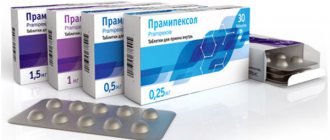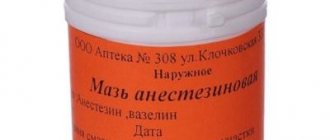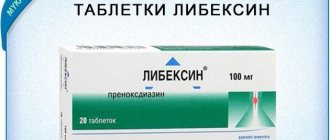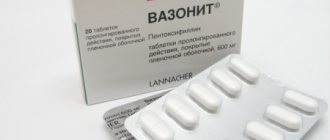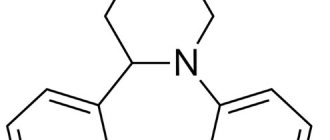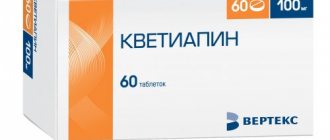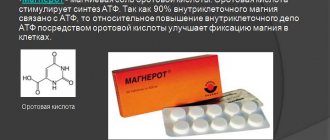Phenazepam is a tranquilizer from the group of benzodiazepines. It is available in the form of tablets and as a solution for injection. The drug is used to treat mental disorders accompanied by agitation, hyperexcitability in neurology, and withdrawal syndrome in narcology. Also used by anesthesiologists for premedication of anesthesia.
Phenazepam is a strong tranquilizer and has a large number of contraindications and side effects. It is released strictly according to a doctor's prescription. Age under 18 years is included in the list of contraindications for its use.
Varieties of forms
Phenazepam is available in the form of tablets and solution. The tablet form is used more often, since the drug requires long-term use and the injection route may be accompanied by a risk of infection. Large white round tablets. Available in dosages of 0.5, 1 and 2.5 mg.
The solution is suitable for administering the drug intravenously and intramuscularly. Available in ampoules of 1 ml, dosage 1 mg. The phenazepam solution is transparent, some companies have a yellowish tint.
Emergency care for child poisoning with phenazepam
If the baby has taken phenazepam, it is necessary to immediately begin to provide assistance without waiting for the consequences. First of all, you should call an ambulance, explaining the situation and naming the dose taken. The baby should be in a horizontal position under adult supervision.
Emergency care consists of gastric lavage, enemas and sorbents. Hospitalization to the intensive care unit with the inclusion of detoxification and supportive therapy is indicated. The more pills a child has taken, the worse the prognosis.
pharmachologic effect
Phenazepam is one of the most powerful benzodiazepine tranquilizers. In order to understand the mechanism of its action, it is necessary to know about two opposing systems of the brain - excitatory and inhibitory.
Each part of the brain has neurons whose transmitters are responsible for excitation of that part. Such neurons are called excitatory. Other nerve cells are responsible for inhibition, they are called inhibitory. At any given moment, either excitement or depression predominates.
In patients with anxiety disorders, various mental illnesses, psychoactive substance withdrawal syndrome, hyperkinesis, severe pain syndrome, and insomnia, the influence of excitatory neurons predominates. Such excitement negatively affects the condition of patients. In order to return the brain to a state of balance, inhibitory neurons must be activated.
The mechanism of action of benzodiazepines is precisely this activation. They increase the amount of gamma-aminobutyric acid, the main sedative neurotransmitter of the brain, and include structures responsible for inhibiting all processes of the central nervous system. In this way, a sedative effect is achieved. For each specific pathology, the action of the tranquilizer is aimed at suppressing the brain structure whose hyperexcitation led to the onset of the disease. The mechanism is universal for all parts of the brain, which explains the large number of indications for the use of phenazepam.
Comparison of side effects of Phenazepam and Elzepam
Side effects or adverse events are any adverse medical event that occurs in a subject after administration of a drug.
Phenazepam has more adverse effects than Elzepam. This implies that the frequency of their occurrence is low with Phenazepam and low with Elzepam. Frequency of manifestation is an indicator of how many cases of an undesirable effect from treatment are possible and registered. The undesirable effect on the body, the strength of influence and the toxic effect of drugs are different: how quickly the body recovers after taking it and whether it recovers at all. When using Phenazepam, the body's ability to recover faster is higher than that of Elzepam.
Indications for use
Phenazepam is a drug that is used in psychiatry, narcology, neurology and anesthesiology. Its use by psychiatrists is justified in many cases. Phenazepam is prescribed for severe anxiety-phobic disorders, in patients with psychotic and psychopathic conditions, senestopathies, hypochondria, delusional disorder, insomnia, neurasthenia and other mental illnesses requiring sedation.
Narcologists use this medicine in patients with withdrawal symptoms. However, the drug cannot be used while intoxicated. The interaction between phenazepam and alcohol requires more detailed consideration.
In neurology, phenazepam is prescribed for epilepsy, nervous tics and hyperkinetic disorders. Anesthesiologists use it before administering anesthesia for sedative purposes. Sometimes the drug is prescribed by doctors of other specialties for patients with severe pain syndrome, for example, in oncology and traumatology, for hypnotic purposes.
Addiction
Both medications can be addictive, even when taken under medical supervision . But in order to protect yourself at least a little, you need to follow only the prescription, and in no case increase the dose yourself, as this is a sure path to addiction. You need to stop using drugs gradually and under the supervision of a doctor, as withdrawal syndrome may develop.
Contraindications
Phenazepam should not be prescribed in the following cases:
- Individual intolerance to the components of the drug, sensitivity to benzodiazepines;
- Deep depression of consciousness, coma;
- Increased intraocular pressure;
- Pathological decrease in blood pressure;
- Decompensated liver, kidney, heart or lung failure;
- Chronic diseases of the bronchopulmonary system;
- Pregnancy, lactation (prescribing phenazepam to pregnant women has a number of features);
- Children's age (the effect of phenazepam on children has not been sufficiently studied);
- Severe depression;
- History of suicide attempts;
- Myasthenia.
For whom the drug is contraindicated
Considering the intensity of the drug’s effect on the human body, it is not surprising that it has a number of contraindications.
So the medication is strictly not recommended for:
- Pregnancy, especially in the first trimesters and during breastfeeding;
- If the patient is under 18 years of age, Phenazepam is not suitable for the treatment of children and adolescents;
- Angle-closure glaucoma, since taking it can lead to irreversible and complete loss of vision;
- Coma;
- Personal intolerance to the main or auxiliary component of this particular drug or other benzodiazepine drugs;
- Myasthenia gravis is a neuromuscular pathology, which is characterized by the development of excessively rapid fatigue of human skeletal muscles;
- Acute poisoning with alcohol, narcotic and sleeping pills. If applied to an existing problem, the remedy can lead to a serious deterioration in well-being;
- Development of a state of shock;
- Severe form of depression with observed tendencies to suicidal thoughts;
- Severe forms of chronic obstructive pulmonary disease and other pathologies that are accompanied by the formation of acute respiratory failure.
A number of these contraindications are not empty words.
If you ignore the recommendations for taking medication, the risk of developing undesirable and dangerous consequences for the patient increases significantly, which is important to consider and understand
Side effects
Phenazepam, as a benzodiazepine tranquilizer, often causes side effects. The most common are drowsiness, fatigue, and depression of the central nervous system. Possible impairment of cognitive functions, unsteady gait, decreased concentration, and speech-motor disorders. Very rarely the opposite effect occurs - agitation, attacks of aggression, agitation, suicidal attempts.
Side effects such as hypotension and decreased heart rate are considered normal. Sometimes visual disturbances, double vision, and flickering of spots occur. In some patients, phenazepam inhibits the hematopoietic system, leading to a decrease in the content of all blood cells - pancytopenia.
Quite often, at the beginning of therapy, digestive system disorders occur - heartburn, nausea, vomiting, abdominal pain, diarrhea, jaundice. Some patients experience urinary disorders, and almost all have decreased libido.
Why is phenazepam dangerous?
The danger of the drug is based on the fact that it has narcotic properties. Taking it without the knowledge of a doctor can cause irreversible harm to the body. Regular use of the drug destroys the psyche, causing mental disorders. And also the work is disrupted:
- gastrointestinal tract;
- circulatory system;
- genitourinary system;
- of cardio-vascular system.
Each violation leads to the development of multiple pathologies. When prescribing, special attention should be paid to patients who:
It is important to remember that phenazepam is not compatible with alcohol.
Phenazepam for pregnant women
Contraindicated for pregnant women and nursing mothers. This is due to the fact that it has a detrimental effect on the fetus:
- suppresses the nervous system;
- destroys the respiratory system;
- a child is born with a defect in the sucking reflex.
But there are exceptions in which the drug can be prescribed to pregnant women:
Pregnant women are not recommended to take phenazepam
- epilepsy;
- convulsions of various types;
- psychiatric diseases;
- neurological diseases.
In all cases, the appointment is made only if the patient cannot cope with the illness on his own. But the born child will be forced to endure the consequences of drug withdrawal, since even in utero it is addictive.
Can phenazepam be used by older people?
Due to the fact that older people have reduced activity of organs, the drug is prohibited for them. Phenazepam is one of the medications that can cause organ dysfunction or aggravate existing diseases.
Phenazepam in narcology
In narcology, this drug is used to treat drug addicts. It is prescribed to alleviate the physical condition of a drug addict. Phenazepam should be taken with caution, as its strong effect on the nervous system can cause anger and attacks of aggression.
There have been cases of severe suppression of the nervous system, which lead to suicide.
Prescription is also possible as replacement therapy. In this case, it is important not to take the medication at the same time as drugs.
Phenazepam poisoning - symptoms
It is very easy to get poisoned by phenazepam. It is enough not to follow the doctor’s recommendations or prescribe treatment yourself. Initially, there may be a feeling of side effects, but symptoms of poisoning will soon appear:
- disorientation;
- weak pulse;
- rare breathing;
- lack of motor reflex;
- constant drowsiness;
- tremor;
- involuntary vertical or horizontal movement of the pupils;
- low pressure;
- confusion.
Phenazepam poisoning in children
This drug is not prescribed for treatment to persons under 18 years of age. Phenazepam poisoning in children is the result of adult carelessness. The drug used by children is very quickly absorbed into the blood due to active metabolism. Therefore, it must be stored out of the reach of children.
If it does happen that the child swallowed the medicine, then the following symptoms begin to appear:
Make sure that phenazepam does not fall into the hands of children
- nausea;
- vomit;
- hallucinations;
- lack of coordination;
- failure to breathe;
- coma.
Having noticed such phenomena, you need to urgently take the child to the hospital, where he will receive qualified assistance.
The main thing in all these actions is to provide assistance on time.
Dosage regimen
In psychiatric practice, treatment with phenazepam begins with a dosage of 1 mg, gradually increasing the amount of the drug. For psychotic conditions, the therapeutic dose is 6 mg. With a pronounced anxiety component, you can start with 3 mg three times a day.
Neurological diseases are treated starting with 2 mg per day. For epilepsy, it is permissible to use a maximum dose of 10 mg. In drug treatment practice, a dose of 5 mg is sufficient. For anesthesia, 0.5–1 mg of the drug is used. When treating insomnia, you can drink 0.5 mg once a day half an hour before bedtime. The approximate duration of action of phenazepam is 18 hours.
For safety reasons, the dose of the drug is increased slowly every 2-3 days until the desired effect is achieved. If the drug has no effect, after 2 weeks it is permissible to switch to another drug. Treatment with phenazepam for two months is considered effective. It is necessary to stop taking it by gradually reducing the dosage. Otherwise, phenazepam withdrawal syndrome is possible.
Safety and efficacy studies
In order for a drug to go on sale in pharmacy chains, it must go through several stages of many years of research. The first stage is testing on laboratory animals, then it is tested on healthy volunteers, and then on volunteers with a certain pathology. And only after that the medicine goes on sale.
There are groups of people for whom effectiveness and safety are determined separately. One such group is children. In order to authorize the use of a medicinal substance by persons under 18 years of age, it is necessary to conduct research on small animals, child volunteers, and sick children. For the last two studies, written parental permission is required.
If the drug showed questionable results at the previous stages of the study, it is not allowed to enter the subsequent stages. For some reason, phenazepam did not reach trials on child volunteers, so its status is defined as: “Effectiveness and safety when used in this group of patients has not been proven.” Sometimes funds receive this status because there are no volunteers.
If one of the stages of research on young patients has not been completed, regardless of the reason, the medicine is contraindicated for use by persons under 18 years of age.
Overdose
If the dose of the drug is exceeded, deep depression of consciousness is observed, up to coma. Speech disturbances, suffocation, persistent arterial hypotension, decreased heart rate, and blurred vision are possible.
The lethal dose is half a milligram per kilogram of body weight for adults and a quarter milligram per kilogram for children. There are known cases of death from simultaneous consumption of the entire contents of a phenazepam package. The United Nations has included phenazepam in the list of substances hazardous to humans, which is why in all countries it is sold strictly according to a prescription.
Let's summarize
Although the opinions of experts are divided on this matter, it is still better to drink Phenazepam after meals or, in the case of insomnia, take the drug 20-30 minutes before bedtime, regardless of food . No one will ever give you better advice than your doctor. Therefore, always consult with him about this, do not increase the dose of Phenazepam on your own, otherwise there may be very bad consequences. When the doctor writes a prescription for Phenazepam, he will tell you everything about whether after or before meals, how much and when to take the drug. Do not self-medicate.
Found a mistake? Select it and press Ctrl + Enter
Instructions
The tablet form is taken orally. If more than 1 mg is prescribed, the daily dosage should be divided into several doses. In this case, most of the medicinal substance should be consumed in the evening, less - in the morning. A dosage of less than 1 mg is acceptable once a day before bedtime.
The solution is administered intravenously in a stream, diluted with water for injection to 10 ml or intramuscularly without dilution. If long-term treatment is necessary, gradually switch to taking tablets orally in the same dosages.
Special instructions for use by children
According to the instructions for the drug, Phenazepam can only be prescribed to persons over 18 years of age.
The use of the drug at an earlier age is prohibited for two reasons. Firstly, studies on the effect of the drug on the children's body have not been conducted, so the consequences of such actions cannot be predicted. Secondly, small tablets are difficult to divide into pieces so that they exactly contain the right amount of active substance. The slightest inaccuracy can lead to an overdose - an emergency condition that in childhood threatens the health of the victim. The high-risk group includes children under 3 years of age. For them, poisoning with the drug can cause death. In a hospital, in case of emergency, they usually resort to using a dosage form in the form of a solution. This allows you to calculate the dosage of the product as accurately as possible, quickly achieve a therapeutic response, and eliminate the risk of blocking the respiratory tract with a tablet. Such manipulations in special situations are prescribed to children who cry for several hours, and other means cannot calm them down. The use of the drug "Phenazepam" allows you to achieve long and sound sleep, after which the baby remains inactive for several hours.
The drug is dangerous for children under 3 years of age; for them, drug poisoning can cause death.
Analogs
Phenazepam is one of the most severe benzodiazepine tranquilizers. The drug may have different trade names:
- Fezanef;
- Elzepam;
- Fesipam;
- Phenorelaxan.
Benzodiazepines with a similar mechanism of action include:
- Alprazolam;
- Diazepam;
- Sibazon;
- Relanium;
- Lorazepam;
- Medazepam.
All of the listed drugs belong to the group of narcotic and precursor substances and are sold strictly according to a prescription. In addition to them, there are so-called “soft” or “daytime” tranquilizers. These are over-the-counter analogues of phenazepam:
- Gidazepam;
- Tazepam;
- Demetrin;
- Grandaxin;
- Trioxazine.
How to help a dementia patient with insomnia
When the disease occurs, patients are often diagnosed with emotional disorders. This causes the development of insomnia, which requires timely treatment. The occurrence of emotional and behavioral disorders is observed in moderate forms of pathology.
If the patient has pronounced depressive disorders, then antidepressants and sedatives will need to be given. The duration of therapy is influenced by the severity of depression.
Most often, the duration of therapy is 6 months. Antidepressants are characterized by a cumulative effect. It is for this reason that the first effect of taking it is observed several weeks after the first use.
The onset of clinical depression can begin for various reasons
It is important to remember that with illiterate therapy, the patient’s condition will worsen. It is recommended that a patient with dementia take medications with hypnotic and sedative effects.
Most often the choice falls on Phenazepam and Diazepam. It is best to choose herbal medicines.
Reviews
Ilya K .: “I have suffered from panic attacks since childhood. These are such causeless attacks of fear that it is impossible to fight on your own. Most often they occur at night, making it impossible to sleep. At first I took mild sedatives, but they didn’t help, now I take phenazepam. The panic attacks have disappeared and I now sleep peacefully. The only negative for me is that I can’t work productively, I feel sleepy all the time. And now you can’t drive a car.”
Karina Kh .: “After retirement, I had problems sleeping. I went to different doctors, they didn’t really find anything for me, but I couldn’t sleep. They prescribed various antidepressants, which practically did not help. In addition, their price did not suit me. About a month ago, the doctor prescribed phenazepam. For two weeks now I have been sleeping peacefully all night until the morning. I am very pleased with the drug."
Doctor's review : “Phenazepam is an effective tranquilizer. I cannot remember a case in which it would not have a therapeutic effect on the patient. It is often used in situations where the patient needs to be calmed. However, I would not prescribe the drug to everyone. Many patients in psychiatric departments have contraindications to the use of this drug. In addition, there is a high risk of side effects. Patients taking this drug should be closely monitored."
Content
Recommended dosage and method of administration of the drug
"Phenazepam" in the form of a solution is intended for injection into a muscle or vein by jet or drip method. A single dose of the drug ranges from 0.0005 to 0.001 g. The maximum permissible dose is 0.01 g.
The following dosage regimen is recommended depending on the patient’s condition and diagnosis:
- For the purpose of relieving psychotic and anxiety states that are not accompanied by aggression and hallucinations - from 0.003 to 0.005 g, which corresponds to 3-5 ml of a 0.1% solution. At the discretion of the attending physician, the dosage may be exceeded by 1.5 times.
- For epileptic seizures, the drug is administered in a dose of 0.0005 g or more, depending on the diagnosis made by the doctor.
- During the period of withdrawal syndrome provoked by chronic alcoholism or drug addiction, the dosage of the administered drug is from 0.0025 to 0.005 g.
- If it is necessary to prepare the patient for anesthesia, the drug should be administered very slowly intravenously several hours before surgery at a dose of 0.003 to 0.004 g.
The average duration of treatment with Phenazepam is two weeks. In some cases, at the discretion of the attending physician, the course may last three or four weeks. But in this case, it is necessary to adjust the dosage so that the risk of developing drug dependence is minimized.
What to do with phenazepam?
I am 32 years old, male, married. A couple of months ago I had trouble and suffered prolonged stress. There was a feeling of anxiety, an incomprehensible fear out of nowhere, a feeling of hopelessness during the day. It appears mainly in the morning after breakfast, but it also occurs at other times of the day. For almost a month I drank different herbal decoctions, all possible tinctures, glycine. There was no tangible help.
The psychiatrist prescribed Phenazepam 1/4 3-4 times a day. She said that it is better to take a little at a time, but more often and only when this anxiety appears, she said that there should be no addiction from such a dosage. I started drinking 1/4 only in the morning when she covers it. The anxiety disappears and becomes much better, but it’s not always until the end, sometimes there is a little left, then after 1-2 hours I drink a quarter.
I do not take phenazep all the time, but only as needed. I can drink it for 4 days every day, and then for 2-3 days I don’t even look in its direction, I take it shorter as needed. So far I don’t see any addiction, there is no weakness or drowsiness. On the contrary, after I take 1/4 of the tablet, I become more cheerful because I stop being afraid. It’s a pity that it doesn’t always work, and it’s scary to increase the dose. And I don’t have the strength to stop drinking it. Please advise what to do? Thank you.
Answer to the question:


